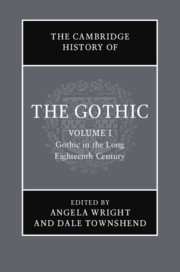Book contents
- The Cambridge History of the Gothic
- The Cambridge History of the Gothic
- The Cambridge History of the Gothic
- Copyright page
- Contents
- Illustrations and Captions for Volume I
- Notes on Contributors
- Acknowledgements
- Introduction: The Gothic in/and History
- 1.1 The Goths in Ancient History
- 1.2 The Term ‘Gothic’ in the Long Eighteenth Century, 1680‒1800
- 1.3 The Literary Gothic Before Horace Walpole’s The Castle of Otranto
- 1.4 Gothic Revival Architecture Before Horace Walpole’s Strawberry Hill
- 1.5 Horace Walpole and the Gothic
- 1.6 Shakespeare’s Gothic Transmigrations
- 1.7 Reassessing the Gothic/Classical Relationship
- 1.8 ‘A World of Bad Spirits’: The Terrors of Eighteenth-Century Empire
- 1.9 In Their Blood: The Eighteenth-Century Gothic Stage
- 1.10 Domestic Gothic Writing after Horace Walpole and before Ann Radcliffe
- 1.11 Early British Gothic and the American Revolution
- 1.12 Gothic and the French Revolution, 1789–1804
- 1.13 The Aesthetics of Terror and Horror: A Genealogy
- 1.14 Ann Radcliffe and Matthew Lewis
- 1.15 The Gothic Novel Beyond Radcliffe and Lewis
- 1.16 Oriental Gothic: Imperial-Commercial Nightmares from the Eighteenth Century to the Romantic Period
- 1.17 The German ‘School’ of Horrors: A Pharmacology of the Gothic
- 1.18 Gothic and the History of Sexuality
- 1.19 Gothic Art and Gothic Culture in the Romantic Era
- 1.20 Time in the Gothic
- Select Bibliography
- Index
1.19 - Gothic Art and Gothic Culture in the Romantic Era
Published online by Cambridge University Press: 16 July 2020
- The Cambridge History of the Gothic
- The Cambridge History of the Gothic
- The Cambridge History of the Gothic
- Copyright page
- Contents
- Illustrations and Captions for Volume I
- Notes on Contributors
- Acknowledgements
- Introduction: The Gothic in/and History
- 1.1 The Goths in Ancient History
- 1.2 The Term ‘Gothic’ in the Long Eighteenth Century, 1680‒1800
- 1.3 The Literary Gothic Before Horace Walpole’s The Castle of Otranto
- 1.4 Gothic Revival Architecture Before Horace Walpole’s Strawberry Hill
- 1.5 Horace Walpole and the Gothic
- 1.6 Shakespeare’s Gothic Transmigrations
- 1.7 Reassessing the Gothic/Classical Relationship
- 1.8 ‘A World of Bad Spirits’: The Terrors of Eighteenth-Century Empire
- 1.9 In Their Blood: The Eighteenth-Century Gothic Stage
- 1.10 Domestic Gothic Writing after Horace Walpole and before Ann Radcliffe
- 1.11 Early British Gothic and the American Revolution
- 1.12 Gothic and the French Revolution, 1789–1804
- 1.13 The Aesthetics of Terror and Horror: A Genealogy
- 1.14 Ann Radcliffe and Matthew Lewis
- 1.15 The Gothic Novel Beyond Radcliffe and Lewis
- 1.16 Oriental Gothic: Imperial-Commercial Nightmares from the Eighteenth Century to the Romantic Period
- 1.17 The German ‘School’ of Horrors: A Pharmacology of the Gothic
- 1.18 Gothic and the History of Sexuality
- 1.19 Gothic Art and Gothic Culture in the Romantic Era
- 1.20 Time in the Gothic
- Select Bibliography
- Index
Summary
While Gothic scholars of the last two or three decades have explored forms of Gothic sensation, spectacle or visuality, they have generally had as their focus illustrations, caricature prints, graphic ephemera and advertising material rather than oil paintings and watercolours by the famous artists associated with Romanticism. This chapter considers precisely those works of art that have defined Romanticism. The more circumscribed notion of art and the artist associated with the ‘autonomisation’ of art around 1800 is here tied to the emergence of Gothic forms and themes within painting. It is argued that it is more than coincidental that the chronology of the original phase of Gothic literary and cultural production matches that of the development of aesthetics as philosophical discourse, and the ‘invention of art’ as a relatively autonomous field of activity. That a full-blooded Gothic art subsequently resurfaces only intermittently in the history of ‘high art’ exposes not only the volatility and inconstancy of Gothic culture, or the irreconcilability of the Gothic and art, but also the general ambivalence towards the indeterminacies of art in the modern era.
Keywords
- Type
- Chapter
- Information
- The Cambridge History of the GothicVolume 1: Gothic in the Long Eighteenth Century, pp. 406 - 425Publisher: Cambridge University PressPrint publication year: 2020



